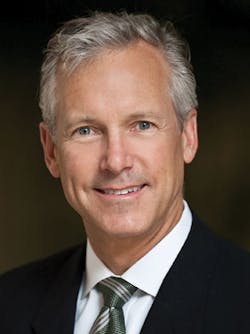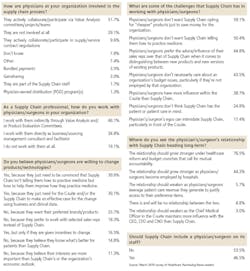Physicians, surgeons should seek common ground with Supply Chain leaders
Regardless of clinical setting, physicians and surgeons grapple with a score of challenges that range from reform and reimbursement pressures to malpractice and the patient care benefits and costs of new and existing technologies that foment frustration and burnout.
Regardless of clinical setting, Supply Chain leaders and staff juggle their own set of challenges that range from reform and reimbursement pressures to physician preference issues and the patient care and economic viability and justification of products and services brought into the facility that ignite exasperation and at least partial surrender.
At one end, these two groups seem to be plotting parallel pathways, running adjacent courses; at the other end, these two groups seem to be united in dealing with common — and shared — issues.
Is it possible that healthcare is on the verge of bringing more clinical understanding to Supply Chain and financial and operational acknowledgement to physicians and surgeons?
Two prominent physicians foresee clinical integration with Supply Chain as one of the next big things in healthcare that will define the coming decade and elevate both professions by the next one.
John Cherf, MD, MPH, MBA, Chief Medical Officer, Lumere Inc., and former Chief of Orthopedics, Advocate Illinois Masonic Medical Center, Chicago, earned a P.U.R.E. designation by Healthcare Purchasing News back in July for being a Supply Chain-Focused Physician. Michael Suk, MD, JD, MPH, FACS, Chief Physician Officer, Geisinger System Services, and Chair, Musculoskeletal Institute and the Department of Orthopaedic Surgery, Geisinger Health, Danville, PA, earned his P.U.R.E. designation from HPN two years earlier in August 2017. P.U.R.E. stands for Physicians Understanding, Respecting and Engaging Supply Chain professionals. HPN bestows its P.U.R.E. award on those physicians and surgeons who have made solid contributions to supply chain operations — activities, practices and thinking. HPN designed it to further solidify and strengthen the clinical bonds between physicians and supply chain professionals.
Both doctors Cherf and Suk explored with HPN Senior Editor Rick Dana Barlow the possibilities and promise of physicians and surgeons clinically integrating with Supply Chain in a wide-ranging interview, in advance of their educational session at AHRMM 2019 in San Diego in late July.
HPN: Several surveys have addressed the changing status of physicians in hospitals that may correlate with their professional relationships with Supply Chain. For example, a recent survey showed that a majority of physicians working at hospitals now are employed by those facilities rather than being independent with operating privileges. Another study conducted last year by your organization showed that aligned/employed physicians are less influenced by product preference and supplier sales strategies and tactics than those not employed by the facilities where they practice. How do you see both developments impacting, if not reshaping, their ties with Supply Chain?
In addition, alignment does not necessarily guarantee buy-in in terms of addressing clinical variation. As we educate ourselves more and more on the cost of care, we’re going to see greater alignment of physicians with Supply Chain, regardless of hospital employment.
Dr. Suk: The AMA recently published a study, which demonstrated for the first time in history, that a slight majority of physicians are now employed, rather than independent. It signals a potentially significant change in the relationships between physicians and their hospitals. This trend could have a positive impact by aligning goals when it comes to the overall health and wellbeing of the enterprise. When goals are aligned and information is readily shared, traditional sales tactics that influence product preference or use is sharply mitigated.
What are some tips you can share on how Supply Chain can work more effectively with “independent” physicians?
Dr. Cherf: It’s crucial that Supply Chain share meaningful data with physicians. Physicians are empiricists, so they’re motivated by data. As a result, health systems should supply meaningful data at a consistent cadence to physicians—perhaps, every quarter. The data provided needs to be balanced: not overwhelming and not too frequent.
Supply Chain professionals need to be upfront and transparent with physicians. Hospitals historically have been reluctant to say, “We need to take X number of dollars out of our devices costs.” Supply Chain has the data and expertise to address these issues and needs to share that information with clinicians.
Dr. Suk: The most important thing to do is to be open with data and welcome partnership in achieving the strategic goals of the organization. Independent physicians, at their core, recognize that they’re in a symbiotic relationship with the entities with which they work. Hospital systems that work with independent physicians, would do best by bringing them into the supply chain decision making and be respectful of and consider their clinical opinion. Scheduling a meeting when it better suits a clinical or operating room schedule is an easy first step toward signaling partnership.
“Show me the data” has been a popular refrain cited by physicians and Supply Chain leaders as the secret to working together successfully. Unfortunately, some physicians may use it as an excuse to rebuff Supply Chain efforts to control costs (through such tactics as switching brands under contract); some in Supply Chain may use evidence-based outcomes as a lure to connect with and influence physicians. How should Supply Chain leaders dance around pandering, persuasion, participation and political maneuvering and focus more on patient outcomes as mutual motivation?
Dr. Cherf: I think you need to have good physician-centric data. All changes need to improve quality or at least be quality-neutral. Physicians are largely driven by patient outcomes. Our mission is to take care of patients and improve their health. Physicians also have enormous legal exposure, so asking them to make changes is a tradeoff between upside and potential significant downside.
Dr. Suk: If supply chain and physician leaders agree at the outset that patients are at the center of care, then it is a small step to agree evidence-based principles should guide their decision making. Keeping in mind those items that bring the most value to patient care as defined by outcomes/cost can be a helpful equation when choices are not obvious. But once the data is shown, there should be an organizational and individual physician commitment to say, “This is the best evidence we have today. This is how we’re going to move forward.”
Using evidence-based data may be Supply Chain’s strategy to work with doctors, but is that enough of a tactic to convince them to change product purchasing behaviors that may run counter to facility finances, policies and contracts? What more is needed and why?
Dr. Cherf: One option is to place some restriction on the number of vendors used, but not to the point that you’re completely limiting physician preference items or forcing surgeons to use specific products. It’s more effective to approach a group of physicians and say, “This is our budget for spine implants or total knees. It’s important for your vendors to be able to work within those parameters.”
Dr. Suk: Context is very important for supply chain decision making. As such, organizations should be very transparent regarding what relationships drive their supply chain decision-making. If they’re using a group purchasing organization, they should explain the nature of those relationships to physicians. In my experience, physicians understand economies of scale, price sensitivity and market trends and want to play a role in finding solutions.
Through purchased products and services (which include third-party, outsourced, contractual labor), Supply Chain remains positioned to overtake Labor as a healthcare organization’s largest cost/expense stream. Historically, when a facility needed to cut costs, it typically targeted labor (laying off staff) and service lines (cutting the costly ones), while also squeezing Supply Chain through budgetary edicts to demand price concessions/reductions from suppliers and to lower clinical consumption/usage patterns where possible. With more physicians joining the hospital’s labor pool, how might that encourage and motivate them to be mindful of budgets, costs and supporting their employer?
Dr. Cherf: Just having physicians joining the labor pool is not enough to drive change. It’s not realistic to expect physicians to automatically show up, go to committee meetings and do additional work for no additional compensation. It’s probably more effective to reward physicians with some of the savings, for example, through gainsharing.
Physicians are overwhelmed. Hospitals need to be respectful of the pressures physicians are under. I’m more optimistic about how hospital physician leaders can drive change than I am about physicians being employed by hospitals. As we see more physician leaders running hospitals the disconnect between administration and practicing physicians will decrease. Many hospital administrators don’t have their arms around the clinical practice of medicine, so it’s important to have physicians — who have spent part of their career in clinical practice — leading conversations around quality of care and Supply Chain costs.
When under stress, hospital organizations often react by cutting labor services and supply chain costs. With Supply Chain and Physician partnerships, services can be achieved through the elimination of waste and streamlining best evidence protocols.
Back in the 1990s, healthcare organizations tried to standardize patient care practices under clinical pathways as part of healthcare reform efforts. How much sense does it make for physicians to design care parameters not only for specific patient demographics but also to incorporate supply chain factors into the mix as sort of clinical pathways 2.0?
Dr. Cherf: We have access to much better data today than we did in 1990, so this data can be utilized to create algorithms and care pathways for high-volume procedures, like knee arthroscopy, total hip replacements and spinal fusions, etc. There’s enough data to identify what needs to be done along the care continuum to improve quality and reduce costs.
Dr. Suk: The premise of clinical pathways is to bring evidence-based medicine into clinical decision-making for the purpose of eliminating individual, unwarranted clinical variation. The analogy rings true in supply chain in a similar fashion. While the product categories may be larger, if you created a clinical pathway around the diabetic foot ulcer to eliminate individual, unwarranted variation in the treatment, then it’s not a very big stretch for us to then add onto that the certain product categories that would be useful within each particular step. So, while clinical pathways 1.0 may have focused purely on clinical decision-making, with 2.0 it makes sense to begin to then include product categories that would supportive of those clinical decisions in a cost-effective, outcomes-based way.
How much of an advantage does a supplier’s “repless model” offer physicians and hospitals and why?
Dr. Cherf: The repless model is a double-edged sword. Many hospitals and health systems have become very dependent on the rep, who sometimes is the most educated person in the room about a particular device. Having said that, if a hospital has a competent staff in the operating room, you may not need the rep. People talk a lot about taking the rep out of the equation. The rep commission is usually about 9 percent. Is it really worth a 9 percent savings to add staff or further educate staff, replace inventory, etc.?
Dr. Suk: When a company rep that sells equipment or implants in a hospital, there is concern that their incentive is to solely upsell products and perhaps use more for personal gain. The idea of a repless model makes sense if viewed solely from that lens. But that is a very binary way to look at it. What the rep-less model tends to avoid discussing is the underlying reason why, in operating rooms, the rep exists. Commonly, in operating room environments, the rep is one of the most valuable and consistent members of the operating room team. At a given time, the physician will always have the same rep, but they may have different nurses, techs or anesthesiologists. Reps facilitate cases, teach new nurses and technicians and play and an important role in the communication stream. Unfortunately, unless and until there is a clear reconciliation of this gap — reps will continue to play an important role in most hospitals.
Why does it make sense for Supply Chain either to have a practicing physician on staff or have a physician in some other type of leadership role in the department?
Dr. Cherf: Having a physician as part of the hospital and Supply Chain leadership team is important. Physicians can help Supply Chain on the clinical side and provide some credibility for conversations with doctors. People in Supply Chains typically don’t have clinical backgrounds, so filling that gap with a physician leader is a great strategy.
Dr. Suk: A practicing physician can bring a broader context to supply chain discussion. It’s important for supply chain leaders to have context from a clinical perspective. The right clinical leader on the supply chain side is someone who’s practicing, who can bridge the gap, and who can translate the language of supply chain back to the medical staff.
Conversely, why might having a practicing physician on the supply chain staff result in some disadvantages?
Dr. Cherf: Supply Chain needs doctors and doctors need Supply Chain staff. One disadvantage is the stress it can add to physician relationships. A doctor who’s part of the Supply Chain may need to have difficult conversations with their colleagues that could compromise future collaborative initiatives. In other words, I might be perceived as a “suit.” Lastly, it’s important to ask if it is good use of physician time to sit in Supply Chain meetings from a financial perspective.
Dr. Suk: I don’t really see any true disadvantages to having a practicing physician work with supply chain. It’s important to have the right person in the role, though. The right person is someone who has a communication style that enables open dialogue, and that also translates the differing alignment or incentives that exist on both sides of the equation. You also need someone who believes in the mission, and someone who understands that supply chain is critical to the clinical value.
If you were to design a quick, easy-to-remember, 10-step blueprint for Supply Chain to work effectively with physicians, what would each one sentence step entail?
Dr. Cherf:
1. Clearly identify the problem.
2. Develop an objective.
3. Determine how to measure results.
4. Communicate the objective to the physicians with 100 percent transparency.
5. Solicit key physician participation.
6. Look for benchmarks. (e.g., are you going to align with best practices based on what’s happening elsewhere around the health system, region, country or are you going to be a trailblazer?)
7. Ask physicians what is needed to move the project forward.
8. Implement timelines and processes.
9. Do not burden physicians with unnecessary activities.
10. Reward the physicians, either monetary or non-monetary.
Dr. Suk:
1. Bring evidence.
2. Be transparent about the dollars.
3. Bring context to the cause.
4. Engage in regular meetings.
5. Seek multi-stakeholder input.
6. Have a clinical champion.
7. Ensure effective communication.
8. Don’t be afraid of conflicts of interest but establish clear rules.
9. Commit to change when necessary.
10. Focus on waste.
Physician-Supply Chain ties by the numbers
Back in March, Healthcare Purchasing News surveyed readers on a variety of issues that included professional relationships with physicians and surgeons. In several questions below the responses exceed 100% because respondents were allowed to choose multiple answers.



